Balcony
A balcony (from Italian: balcone, scaffold; cf. Old High German balcho, beam, balketta; probably cognate with Persian term بالكانه bālkāneh or its older variant پالكانه pālkāneh;[1]) is a platform projecting from the wall of a building, supported by columns or console brackets, and enclosed with a balustrade, usually above the ground floor.
Types
The traditional Maltese balcony is a wooden closed balcony projecting from a wall.
By contrast, a 'Juliet balcony' does not protrude out of the building. It is usually part of an upper floor, with a balustrade only at the front, like a small Loggia. Modern Juliet balconies often involve a metal barrier placed in front of a high window which can be opened.
Juliet balconies are named after Shakespeare's Juliet, who, in traditional stagings of the play Romeo and Juliet, is courted by Romeo while she is on her balcony—though the play itself, as written, makes no mention of a balcony, but only of a window at which Juliet appears. Various types of balcony have been used in depicting this famous scene; however the 'balcony of Juliet' at Villa Capuleti in Verona is not a 'Juliet balcony', as it does indeed protrude from the wall of the villa (see photograph below). The Julian Balcony[2] is a slightly larger version of the well-known Juliet Balcony, protruding slightly from the wall, unlike the smaller Juliet balcony, and spanning at least two windows rather than one.
Functions
Sometimes balconies are adapted for ceremonial purposes, e.g. that of St. Peter's Basilica at Rome, when the newly elected pope gives his blessing urbi et orbi after the conclave. Inside churches, balconies are sometimes provided for the singers, and in banqueting halls and the like for the musicians.
A unit with a regular balcony will have doors that open up onto a small patio with railings, a small Patio garden or Skyrise greenery. A French balcony is actually a false balcony, with doors that open to a railing with a view of the courtyard or the surrounding scenery below.
In theatres, the balcony was formerly a stage-box, but the name is now usually confined to the part of the auditorium above the dress circle and below the gallery.
Balconies are part of the sculptural shape of the building allowing for irregular facades without the cost of irregular internal structures.[3]
Notable balconies
One of the most famous uses of a balcony is in traditional stagings of the scene that has come to be known as the "balcony scene" in William Shakespeare's tragedy, Romeo and Juliet (though the scene makes no mention of a balcony, only of a window at which Juliet appears).
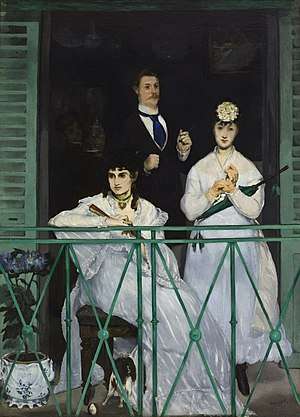 Édouard Manet: Le balcon
Édouard Manet: Le balcon Ford Madox Brown, the balcony scene from Romeo and Juliet
Ford Madox Brown, the balcony scene from Romeo and Juliet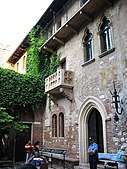 The balcony of Juliet at Villa Capuleti in Verona
The balcony of Juliet at Villa Capuleti in Verona
Balcony names
Manufacturers' names for their balcony designs often refer to the origin of the design, e.g. Italian balcony, Spanish balcony, Mexican balcony, Ecuadorian balcony. They also refer to the shape and form of the pickets used for the balcony railings, e.g. knuckle balcony.
Gallery
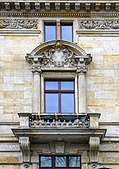 Balcony in Düsseldorf (Germany)
Balcony in Düsseldorf (Germany).jpg)
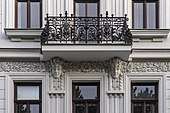 Art Nouveau balcony in Vienna (Austria)
Art Nouveau balcony in Vienna (Austria)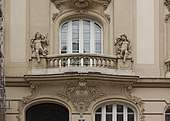 Baroque balcony in Vienna
Baroque balcony in Vienna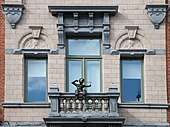 Balcony with a statue of a boy on its balustrade, in Antwerp (Belgium)
Balcony with a statue of a boy on its balustrade, in Antwerp (Belgium)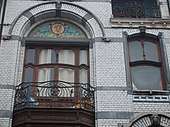 Art Nouveau balcony in Liège (Belgium)
Art Nouveau balcony in Liège (Belgium)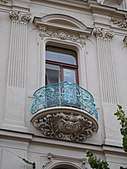 Balcony in Prague (Czech Republic)
Balcony in Prague (Czech Republic)- Renaissance Revival balcony in Brandenburg (Germany)
 Interior balcony in the Saxon Opera House (Dresden, Germany)
Interior balcony in the Saxon Opera House (Dresden, Germany)- Balcony in Dresden
_(2169).jpg) Two balconies on a building from Dresden
Two balconies on a building from Dresden- Neoclassical balcony in Paris
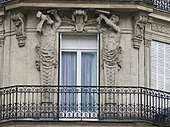 Wrought iron balcony in Paris
Wrought iron balcony in Paris%2C_nearby_Pia%C8%9Ba_Victoriei_(Victoriei_Square)%2C_from_downtown_Bucharest_(Romania).jpg)
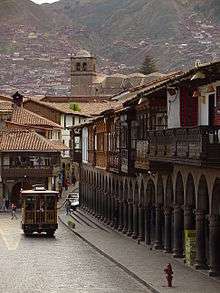 Colonial Balconies of Cusco (Peru)
Colonial Balconies of Cusco (Peru)
See also
References
- Dehkhoda Persian Dictionary
- "Julian's balcony scene deserves only catcalls". 20 August 2012.
- Lorinc, John (16 August 2017). "The rise of the balcony". The Globe and Mail. Retrieved 19 August 2017.
- Asociación de Funcionarios del Servicio Diplomático del Perú. "UNA VISITA AL PALACIO DE TORRE TAGLE, CASA DE LA DIPLOMACIA PERUANA" (in Spanish).
External links
| Look up balcony in Wiktionary, the free dictionary. |
![]()
- . Encyclopædia Britannica (11th ed.). 1911.
_en_balkon_-_Groningen_-_20387674_-_RCE.jpg)
.jpg)
.jpg)